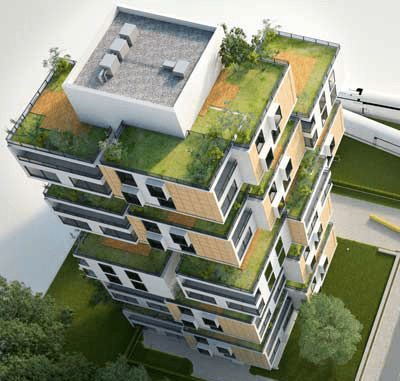GVS Raghavendra Rao
CEPT University Ahmedabad, India
Corresponding Author: raghav@terraviridis.co.uk
Swati Puchalapalli
TerraViridis, Hyderabad, India
Cite this article
Highlights
- The purpose of the study is to assess net-zero energy potential for a proposed apartment building.
- The study is conducted for a proposed G+12 apartment building located in Sonipat, NCR.
- After applying three different identified internal profiles (low-mid-high consumption) the BAU case EUI is in the range of 92 to 88.
- ECM’s – IMAC MM 90% temp. setpoints, shading, NV, efficient envelope, efficient PTAC system were identified as energy conservative measures (ECM’s).
- After all ECM’s were applied one upon another the EUI is in the range of 37 to 31 (66% reduction from BAU case). Which gives a payback period of 8 months.
Abstract
The floor area of residential buildings in India is evaluated twofold (16.0 billion m2 to 31.6 billion m2) and the residential energy consumption is assessed to trifold (246 TWh/y to 748 TWh/y) between 2017 and 2030, as per NITI Aayog (2015). This development of residential floor space, combined with an increment in electricity production, leads to critical energy demand within the up-and-coming decades.
The purpose of the study is to assess net-zero energy potential for a proposed apartment building, suggest effective energy conservative measures, and see the financial achievability of the same by reporting the payback period and internal rate of return (IRR).
Keywords
Net-zero Energy, Residential Buildings, Internal Rate of Return, Simulation, Energy Savings, Incremental Cost, Eco-Niwas Samhita.
References
- International Monetary Fund, 1 April 2021. [Online]. Available: https://www.imf.org/en/Countries/IND.
- UN, “World Population Prospects 2019,” United Nations Secretariat, New York City, 2019.
- GoI, “HOUSING – Statistical Year Book India,” Ministry of Statistics & Programme Implementation, 2017.
- I. Sartori, A. Napolitano, and K. Voss, “Net zero energy buildings: A consistent definition framework,” Energ. and Buildings, vol. 48, pp. 220-232, May 2012. https://doi.org/10.1016/j.enbuild.2012.01.032
- E. Ringold, 1 April 2021. [Online]. Available: https://www.kw-engineering.com/best-practices-successful-building-energy-modeling-energyplus/.
- Eurostat, “Manual for statistics on energy consumption in households,” Eurostat, 2013.
- J. Fernando, ” Internal Rate of Return (IRR): Formula and Examples,” 01 April 2021. [Online]. Available: https://www.investopedia.com/terms/i/irr.asp#:~:text=The%20internal%20rate%20of%20return,a%20discounted%20cash%20flow%20analysis.

 Bishal Thapa
Bishal Thapa





 Fred Sherman
Fred Sherman Sumedha Malaviya
Sumedha Malaviya Satish Kumar
Satish Kumar












 The three main global energy concerns of providing access to modern energy, enhancing the security of the energy supply, and minimising the impact of energy systems on the climate have an impact on both national and international energy governance. To develop solutions that address the many facets of these difficulties, however, a variety of actors and stakeholders must be included due to the complexity of the energy challenges.
The three main global energy concerns of providing access to modern energy, enhancing the security of the energy supply, and minimising the impact of energy systems on the climate have an impact on both national and international energy governance. To develop solutions that address the many facets of these difficulties, however, a variety of actors and stakeholders must be included due to the complexity of the energy challenges. Cities are responsible for more than 70% of the world’s energy consumption and 40% to 50% of its greenhouse gas emissions. Managing increasing urbanisation is a challenge, and nations must deal with the effects it will have on the environment in terms of energy and climate.
Cities are responsible for more than 70% of the world’s energy consumption and 40% to 50% of its greenhouse gas emissions. Managing increasing urbanisation is a challenge, and nations must deal with the effects it will have on the environment in terms of energy and climate. Our transition to a future with lower carbon emissions depends heavily on buildings. They are our places of residence, rest, and employment; they also account for around one-third of the world’s greenhouse gas emissions and nearly 40% of the world’s energy usage.
Our transition to a future with lower carbon emissions depends heavily on buildings. They are our places of residence, rest, and employment; they also account for around one-third of the world’s greenhouse gas emissions and nearly 40% of the world’s energy usage.